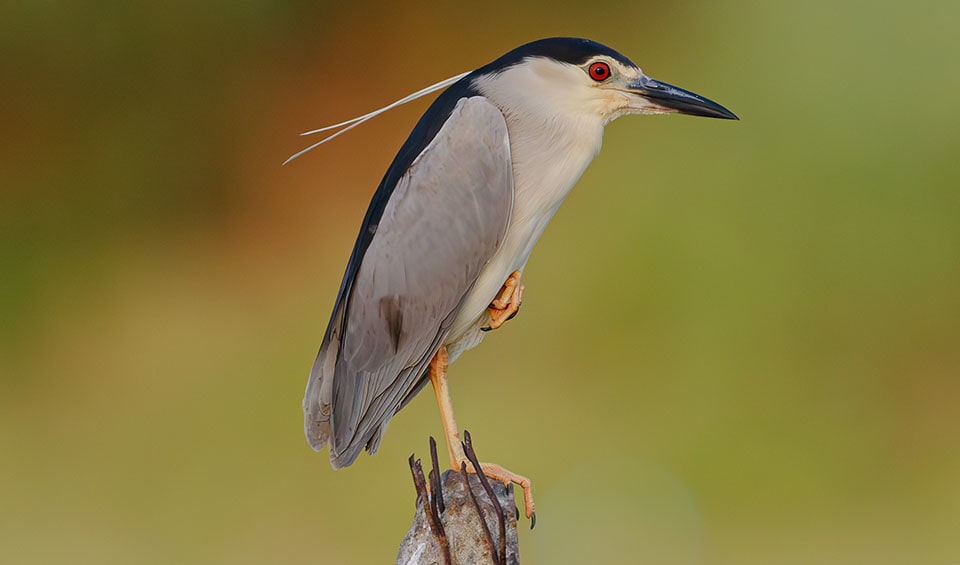Found on every continent except Australia and Antarctica, this striking bird is known for its stocky build, red eyes, and nocturnal lifestyle. Unlike the tall, graceful silhouettes of other herons, the black-crowned night heron has a shorter neck and legs, giving it a more hunched, compact appearance—especially when perched. Its name comes from the glossy black feathers on its crown and back, which contrast beautifully with its gray wings and white underparts.
During the breeding season, they grow two long, white plumes that extend from the back of the head, adding an elegant flair. Their bright red eyes help them see well in low light, and they are most active during the early evening, night, and dawn, when many other herons are resting. This gives them less competition for food and allows them to hunt in relative peace.
Black-crowned night herons are opportunistic feeders, which means they’ll eat whatever they can catch. Their diet includes fish, frogs, crustaceans, insects, small mammals, and even the eggs and chicks of other birds. They use a sit-and-wait technique—standing still for long periods before striking quickly with their sharp beaks. You’ll often see them perched silently near the water’s edge, barely moving as they wait for the perfect moment to snatch a meal.
Juvenile black-crowned night herons look very different from adults. They are brown and speckled with white, giving them excellent camouflage among reeds and brush. It takes about three years for them to develop the sleek, adult plumage. Another fun detail: they are social nesters and often build nests in large colonies, sometimes with hundreds of birds crowded into the same area. Their stick nests are placed in trees, shrubs, or even on manmade structures like bridges and buildings.
Distribution
 Afghanistan
Afghanistan Albania
Albania Algeria
Algeria Angola
Angola Anguilla
Anguilla Antigua & Barbuda
Antigua & Barbuda Argentina
Argentina Armenia
Armenia Aruba
Aruba Australia
Australia Austria
Austria Azerbaijan
Azerbaijan Bahamas
Bahamas Bahrain
Bahrain Bangladesh
Bangladesh Barbados
Barbados Belarus
Belarus Belgium
Belgium Belize
Belize Benin
Benin Bermuda
Bermuda Bhutan
Bhutan Bolivia
Bolivia Bonaire Sint Eustatius And Saba
Bonaire Sint Eustatius And Saba Bosnia And Herz.
Bosnia And Herz. Botswana
Botswana Brazil
Brazil British Virgin Is.
British Virgin Is. Brunei
Brunei Bulgaria
Bulgaria Burkina Faso
Burkina Faso Burundi
Burundi Cambodia
Cambodia Cameroon
Cameroon Canada
Canada Cape Verde
Cape Verde Cayman Islands
Cayman Islands Central Af. Rep.
Central Af. Rep. Chad
Chad Chile
Chile China
China Cocos Is. (Keeling)
Cocos Is. (Keeling) Colombia
Colombia Comoros
Comoros Congo-Brazzaville
Congo-Brazzaville Costa Rica
Costa Rica Croatia
Croatia Cuba
Cuba Curaçao
Curaçao Cyprus
Cyprus Czechia
Czechia Côte D’ivoire
Côte D’ivoire DR Congo (Kinshasa)
DR Congo (Kinshasa) Denmark
Denmark Djibouti
Djibouti Dominica
Dominica Dominican Republic
Dominican Republic East Timor
East Timor Ecuador
Ecuador Egypt
Egypt El Salvador
El Salvador Equatorial Guinea
Equatorial Guinea Eritrea
Eritrea Eswatini
Eswatini Ethiopia
Ethiopia Falkland Islands
Falkland Islands Faroe Islands
Faroe Islands Finland
Finland France
France French Guiana
French Guiana French Southern T.
French Southern T. Gabon
Gabon Gambia
Gambia Georgia
Georgia Germany
Germany Ghana
Ghana Gibraltar
Gibraltar Greece
Greece Greenland
Greenland Grenada
Grenada Guadeloupe
Guadeloupe Guam
Guam Guatemala
Guatemala Guinea-Bissau
Guinea-Bissau Guinea
Guinea Guyana
Guyana Haiti
Haiti Honduras
Honduras Hong Kong
Hong Kong Hungary
Hungary Iceland
Iceland India
India Indonesia
Indonesia Iran
Iran Iraq
Iraq Ireland
Ireland Israel
Israel Italy
Italy Jamaica
Jamaica Japan
Japan Jordan
Jordan Kazakhstan
Kazakhstan Kenya
Kenya Korea
Korea Kuwait
Kuwait Kyrgyzstan
Kyrgyzstan Laos
Laos Lebanon
Lebanon Lesotho
Lesotho Liberia
Liberia Libya
Libya Liechtenstein
Liechtenstein Luxembourg
Luxembourg Macao
Macao Madagascar
Madagascar Malawi
Malawi Malaysia
Malaysia Maldives
Maldives Mali
Mali Malta
Malta Martinique
Martinique Mauritania
Mauritania Mayotte
Mayotte Mexico
Mexico Micronesia
Micronesia Moldova
Moldova Mongolia
Mongolia Montenegro
Montenegro Montserrat
Montserrat Morocco
Morocco Mozambique
Mozambique Myanmar
Myanmar Namibia
Namibia Nepal
Nepal Netherlands
Netherlands Nicaragua
Nicaragua Niger
Niger Nigeria
Nigeria Nort. Mariana Is.
Nort. Mariana Is. North Korea
North Korea North Macedonia
North Macedonia Norway
Norway Oman
Oman Pakistan
Pakistan Palau
Palau Panama
Panama Paraguay
Paraguay Peru
Peru Philippines
Philippines Poland
Poland Portugal
Portugal Puerto Rico
Puerto Rico Qatar
Qatar Romania
Romania Russia
Russia Rwanda
Rwanda Saint Barthélemy
Saint Barthélemy Saint Helena
Saint Helena Saint Lucia
Saint Lucia Saint Pierre
Saint Pierre Saint Vincent
Saint Vincent Saudi Arabia
Saudi Arabia Senegal
Senegal Serbia
Serbia Seychelles
Seychelles Sierra Leone
Sierra Leone Singapore
Singapore Slovakia
Slovakia Slovenia
Slovenia Somalia
Somalia South Africa
South Africa South Georgia
South Georgia South Sudan
South Sudan Spain
Spain Sri Lanka
Sri Lanka St. Kitts & Nevis
St. Kitts & Nevis Sudan
Sudan Suriname
Suriname Sweden
Sweden Switzerland
Switzerland Syria
Syria São Tomé & Príncipe
São Tomé & Príncipe Taiwan
Taiwan Tajikistan
Tajikistan Tanzania
Tanzania Thailand
Thailand Togo
Togo Trinidad & Tobago
Trinidad & Tobago Tunisia
Tunisia Turkmenistan
Turkmenistan Turks & Caicos
Turks & Caicos Turkey
Turkey UAE
UAE US Virgin Islands
US Virgin Islands Uganda
Uganda Ukraine
Ukraine United Kingdom
United Kingdom United States
United States Uruguay
Uruguay Uzbekistan
Uzbekistan Venezuela
Venezuela Vietnam
Vietnam Yemen
Yemen Zambia
Zambia Zimbabwe
ZimbabweAnything we've missed?
Help us improve this page by suggesting edits. Glory never dies!
Suggest an editGet to know me
Terrestrial / Aquatic
Altricial / Precocial
Polygamous / Monogamous
Dimorphic (size) / Monomorphic
Active: Diurnal / Nocturnal
Social behavior: Solitary / Pack / Herd
Diet: Carnivore / Herbivore / Omnivore / Piscivorous / Insectivore
Migratory: Yes / No
Domesticated: Yes / No
Dangerous: Yes / No




